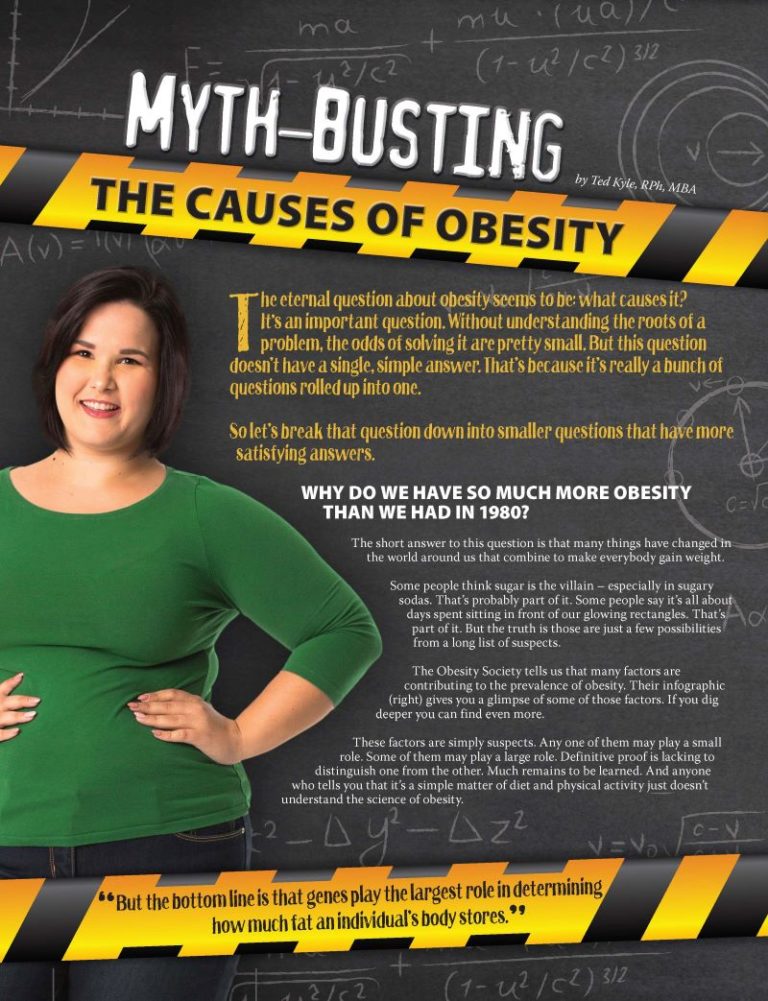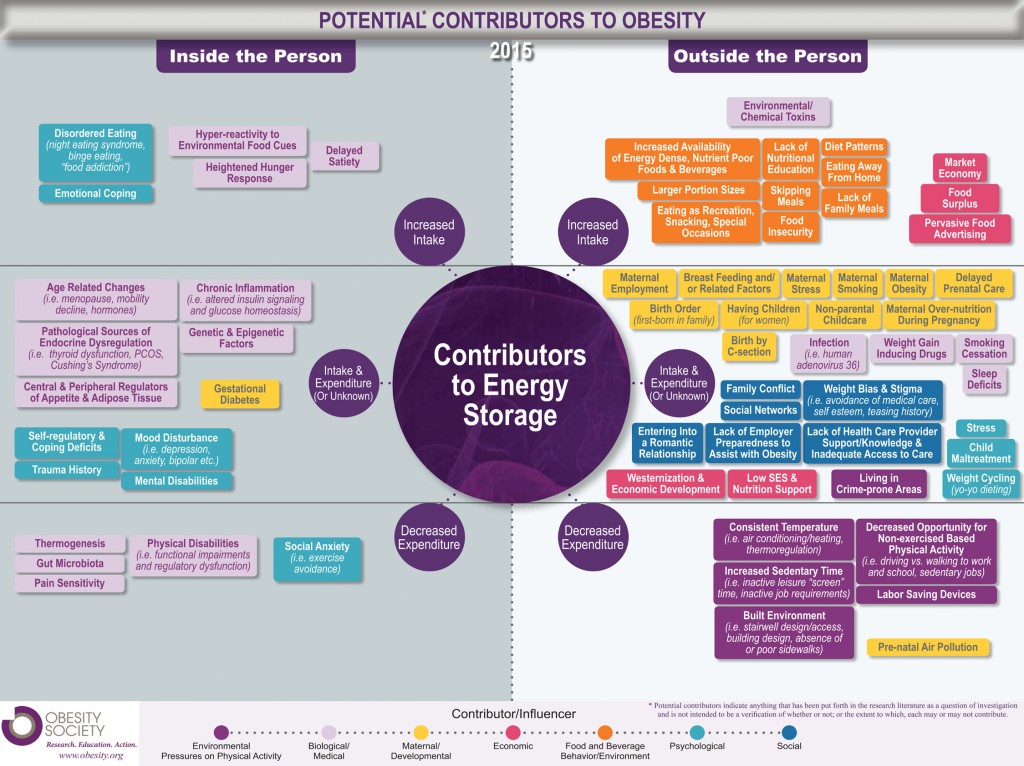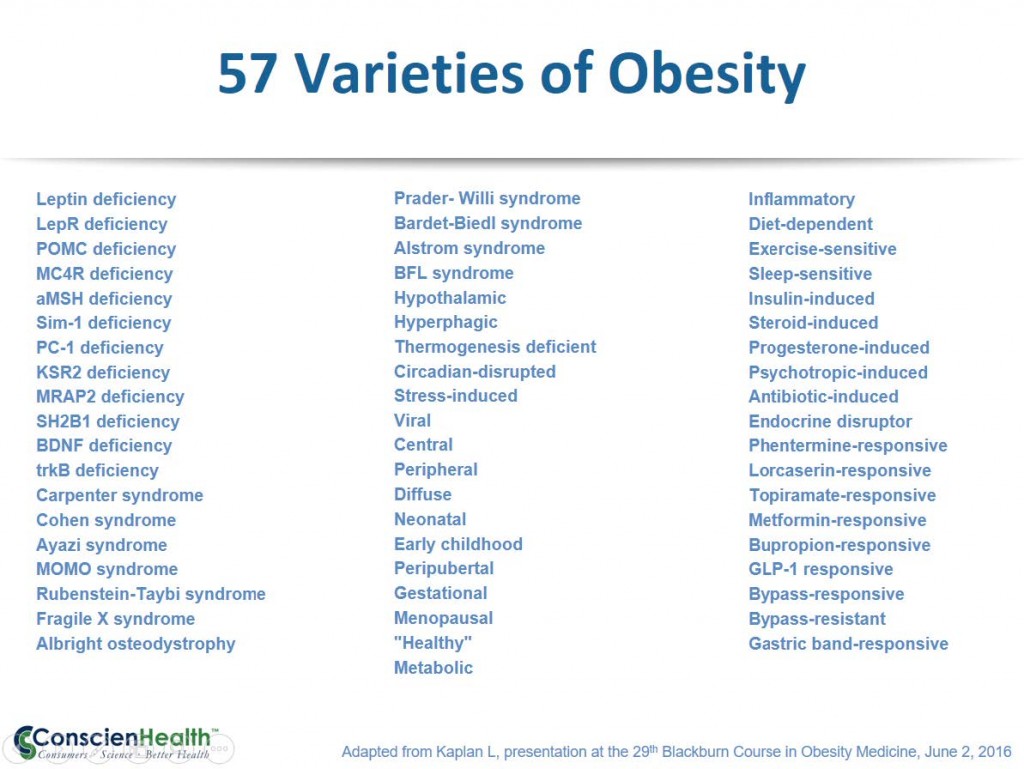Myth-Busting the Causes of Obesity


by Ted Kyle, RPh, MBA
Fall 2016
The eternal question about obesity seems to be: what causes it?
It’s an important question. Without understanding the roots of a problem, the odds of solving it are pretty small. But this question doesn’t have a single, simple answer. That’s because it’s really a bunch of questions rolled up into one.
So let’s break that question down into smaller questions that have more satisfying answers.
Why do we have so much more obesity than we had in 1980?
The short answer to this question is that many things have changed in the world around us that combine to make everybody gain weight. Some people think sugar is the villain – especially in sugary sodas. That’s probably part of it. Some people say it’s all about days spent sitting in front of our glowing rectangles. That’s part of it. But the truth is those are just a few possibilities from a long list of suspects.
The Obesity Society tells us that many factors are contributing to the prevalence of obesity. Their infographic (below) gives you a glimpse of some of those factors. If you dig deeper you can find even more.
These factors are simply suspects. Any one of them may play a small role. Some of them may play a large role. Definitive proof is lacking to distinguish one from the other. Much remains to be learned. And anyone who tells you that it’s a simple matter of diet and physical activity just doesn’t understand the science of obesity.
Why does this person have obesity?
The short answer to that question is that the main reason is in his genes. The stock answer – because he made bad choices or lives a bad lifestyle – is simply wrong. Plenty of people make bad choices or live a bad lifestyle and never develop obesity. Plenty of people are very careful about their lifestyle choices and yet cannot shake their obesity.
Overwhelmingly, a person’s individual risk of obesity is inherited. A 2008 study and commentary found heritability estimated at 77 percent and a total (i.e., shared and non-shared) environmental effect of <25 percent. Estimates of the overall heritability of obesity vary – some as low as 50 percent. Some range much higher. But the bottom line is that genes play the largest role in determining how much fat an individual’s body stores.

Why is it so hard to overcome obesity?
The short answer to this question is that obesity is more than just one single disease. Back in 1971, the American government declared war on cancer and set out to find a cure. Tremendous progress means we’ve come to understand that cancer is a collection of many diseases divided into many different sub-types. Some are curable, some are manageable and some are really hard to deal with.
The smartest scientists working on obesity are learning that the same thing is true for obesity.
Opening the Blackburn Course in Obesity Medicine in Boston this year, Doctor Lee Kaplan presented a compelling rationale for moving past thinking that one size fits all in obesity prevention, diagnosis, or treatment. Kaplan started with a simple definition of obesity – excessive fat accumulation that presents a risk to health – and presented an expansive overview of the wide variety of ways that an unhealthy fat mass can become the set point for different individuals.

To make his point, Kaplan listed 57 potential varieties of obesity (pictured above) and then explored distinguishing characteristics of some of them.
Different pathologies mean that different people respond to different therapies very differently. In bariatric surgery, for example, the average response might be losing about 30 percent of body weight in a given population. But some patients will lose as much as half of their initial body weight. A few will lose very little and eventually regain it.
For every obesity treatment, we see a wide variety of responses. Medical nutrition therapy can bring dramatic responses in some people, alongside minimal responses in other people who initially seem very similar. A drug like liraglutide, which typically causes a loss of 5-10 percent of body weight, produces a loss of up to 30 percent in a few outliers.
The reasons for this diversity are only partially understood. Genetics, epigenetics, environmental factors, and behavioral factors all play a role. The one thing that is clear is that thinking one-size-fits-all in obesity is simply wrong.
Conclusion
No one treatment works for everyone. No one prevention strategy will be adequate to prevent obesity in the next generation. Dogged pursuit of understanding the complexity of this disease is the key. It’s key for developing targeted strategies that will actually work for preventing obesity’s diverse causes. It’s key for developing targeted treatments to relieve the suffering obesity causes in so many forms.
About the Author:
Ted Kyle, RPh, MBA, is a pharmacist and health marketing expert and is also Immediate-Past Chairman of the OAC National Board of Directors.
by Robert Kushner, MD Fall 2021 Disclaimer: Consult with your healthcare provider if you are interested in…
Read ArticleFall 2021 While we can’t always control what happens to us, we can choose how we respond.…
Read ArticleThe Obesity Action Coalition (OAC) and the American College of Physicians (ACP) are proud to offer a…
View Guide










